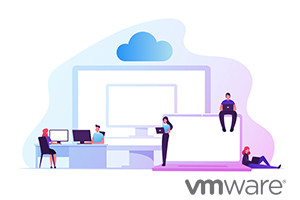If asked to configure virtual machines vSphere, how do you get started? This course outlines how to configure Windows Server and Linux VMs for maximum performance, availability, and security. It introduces you to creating and modifying virtual networks via GUI or the vSphere client. After installing ESXi, it is essential to configure its management network. See how to use the command SU (substitute user) to create a shell under the root user. It is important you learn how to create, and modify virtual networks using CLI because it is faster and it saves time. Storage concepts, ISCSI storage, fibre channel devices, VMSF data storage, and your NAN storage will also be discussed. Once RAW LUNs is presented to an ESXi host, it can be used as a storage container for virtual machine data. You will learn about the steps involved in creating and viewing a VMSF Datastore.
This course provides you with practical information and easy-to-learn modules that teach you how to secure your vSphere machines. Learn about NFS components, as well as how to address and access control with NFS on Linus. See how to create two different interface NFS data storages. This course outlines the purpose of raw device mapping (RDM). Learn how to use RDM to store shared data directly on a LUN in your SAN. The material explains standard licensing, virtual standard installation and inventory within the virtual center. It analyzes managing virtual servers as well as how to plan the vCenter server deployment. It also outlines the requirements for cloning Virtual Machines on a standalone ESX/ESXi. This course further explains how you can troubleshoot the vCenter serve. Study how to handle startup and shutdown situations on virtual machines. This module describes the Start/Stop VMs during the off-hours feature, which starts or stops VMs on a schedule.
Finally, learn how to enforce VM security, including SSH Access and vCenter. Configuration, deployment, optimization, and troubleshooting techniques required to manage vSphere 4.1 are covered. This course will teach you how to secure, protect, and optimize Windows Server and Linux virtual machines The important process of controlling user access and password, active directory integration, managing firewalls, and also SSH access will be analyzed. With ESX only, you master how to run elevated privileges, the switch user, the sudo, and the set UID. You will also learn about the special modes of sudo setuid, and setgid so as to manage your users and permissions. This course is intended for IT professionals with Linux experience who want to learn more about permissions. The course will be helpful in preparing for the Certified Virtualization Expert (CVE) exam from VMware.
What You Will Learn In This Free Course
View All Learning Outcomes View Less All Alison courses are free to enrol, study, and complete. To successfully complete this Certificate course and become an Alison Graduate, you need to achieve 80% or higher in each course assessment.
Once you have completed this Certificate course, you have the option to acquire an official Certificate, which is a great way to share your achievement with the world.
Your Alison certificate is:
- Ideal for sharing with potential employers.
- Great for your CV, professional social media profiles, and job applications.
- An indication of your commitment to continuously learn, upskill, and achieve high results.
- An incentive for you to continue empowering yourself through lifelong learning.
Alison offers 2 types of Certificate for completed Certificate courses:
- Digital Certificate: a downloadable Certificate in PDF format immediately available to you when you complete your purchase.
- Physical Certificate: a physical version of your officially branded and security-marked Certificate
All Certificate are available to purchase through the Alison Shop. For more information on purchasing Alison Certificate, please visit our FAQs. If you decide not to purchase your Alison Certificate, you can still demonstrate your achievement by sharing your Learner Record or Learner Achievement Verification, both of which are accessible from your Account Settings.











 Avg. Hours
Avg. Hours  Contains Video
Contains Video  CPD Accredited
CPD Accredited 
 Total XP:
Total XP: 
 Knowledge & Skills You Will Learn
Knowledge & Skills You Will Learn 







